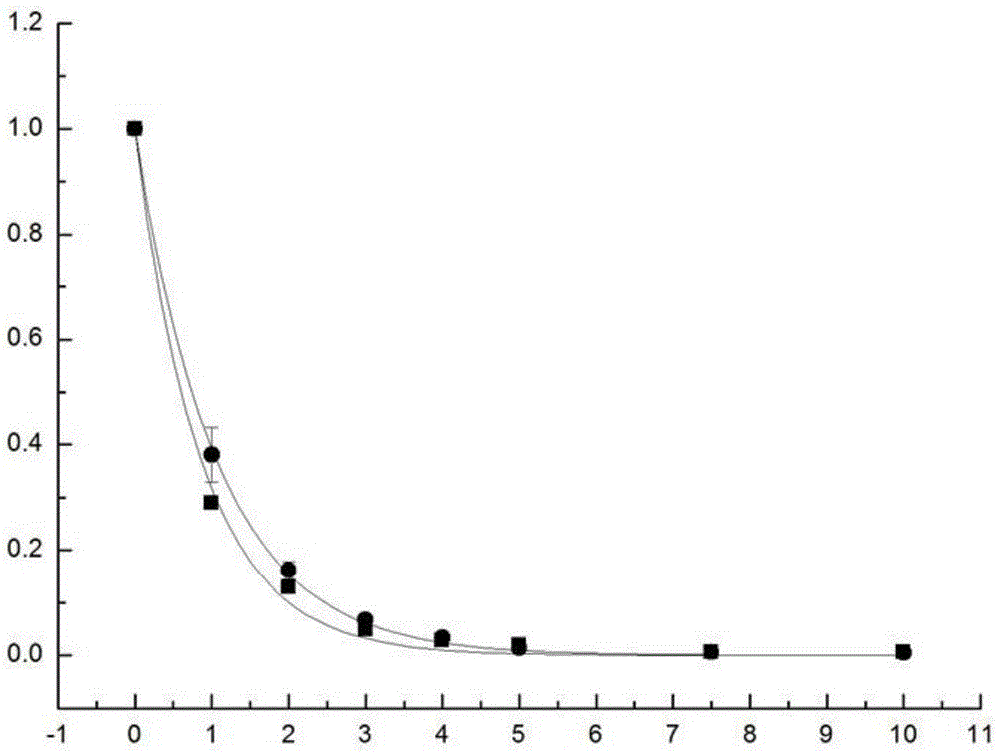Method for improving degradation effect of ochratoxin A (OTA) in solution by using electron beam irradiation
A technology of ochratoxin and electron beam irradiation, which is applied in the direction of protection devices against harmful chemicals, etc., and can solve problems such as complicated operation, restriction, and incomplete degradation
- Summary
- Abstract
- Description
- Claims
- Application Information
AI Technical Summary
Problems solved by technology
Method used
Image
Examples
Embodiment 1
[0025] Embodiment 1, the effect of different rays on OTA degradation effect
[0026] At room temperature,
[0027] The OTA standard stock solution was diluted with water to 100ng / ml, respectively, using 0-10kGy electron beam and 60 Co-γ rays were irradiated.
[0028] Result analysis:
[0029] Such as figure 2 As shown, the x-axis represents the irradiation intensity, the y-axis represents the ratio of the initial concentration of the OTA solution to the concentration after degradation, ■ represents the electron beam, ● represents 60 Co-gamma rays.
[0030] The degradation effect of ochratoxin A in the solution is different with different types of radiation. When the dose is low, the radiation degradation effect of electron beam on OTA is slightly higher than that of 60 Co-gamma rays. At 1kGy, the degradation rates were 70.98% and 61.92%, respectively. With the increase of dose, the increase of degradation rate tends to be stable. At 7.5 kGy, OTA was almost completely...
Embodiment 2
[0031] Embodiment 2, the influence of different solvents on OTA degradation effect
[0032] At room temperature,
[0033] The OTA standard stock solution was diluted to 100 ng / mL with water, acetonitrile, 60% methanol and hydrogen peroxide solution; the electron beam with the intensity of 0-25 kGy was used for irradiation treatment.
[0034] Result analysis:
[0035] Such as image 3 As shown, the x-axis represents the irradiation intensity, the y-axis represents the ratio of the initial concentration of the OTA solution to the concentration after degradation, ■ indicates that the solvent of the OTA solution is water, ● indicates that the solvent of the OTA solution is acetonitrile, and ▲ indicates the solvent of the OTA solution is 60% methanol, ▼ indicates that the solvent of the OTA solution is hydrogen peroxide.
[0036] After electron beam irradiation, OTA was effectively degraded, and the degradation rate of OTA in these four solvents increased with the increase of do...
Embodiment 3
[0037] Embodiment 3, initial concentration is to the degradation effect test of OTA in the aqueous solution
[0038] At room temperature,
[0039] Three OTA aqueous solutions with different concentrations of 50ng / mL, 100ng / mL and 200ng / mL were prepared and irradiated by electron beams with an intensity of 0-25kGy.
[0040] Result analysis
[0041] Such as Figure 4 As shown, the x-axis represents the irradiation intensity, and the y-axis represents the ratio of the initial concentration of the OTA aqueous solution to the concentration after degradation. OTA aqueous solution with a concentration of 200ng / mL.
[0042]The initial concentration of OTA aqueous solution has certain influence on the degradation of OTA. The degradation rate of OTA in the three OTA aqueous solutions was 50ng / ml>100ng / ml>200ng / ml in turn, that is, low initial concentration was beneficial to the degradation of OTA. At 5kGy, the degradation rates of three different concentrations of OTA aqueous solut...
PUM
 Login to View More
Login to View More Abstract
Description
Claims
Application Information
 Login to View More
Login to View More - R&D
- Intellectual Property
- Life Sciences
- Materials
- Tech Scout
- Unparalleled Data Quality
- Higher Quality Content
- 60% Fewer Hallucinations
Browse by: Latest US Patents, China's latest patents, Technical Efficacy Thesaurus, Application Domain, Technology Topic, Popular Technical Reports.
© 2025 PatSnap. All rights reserved.Legal|Privacy policy|Modern Slavery Act Transparency Statement|Sitemap|About US| Contact US: help@patsnap.com



